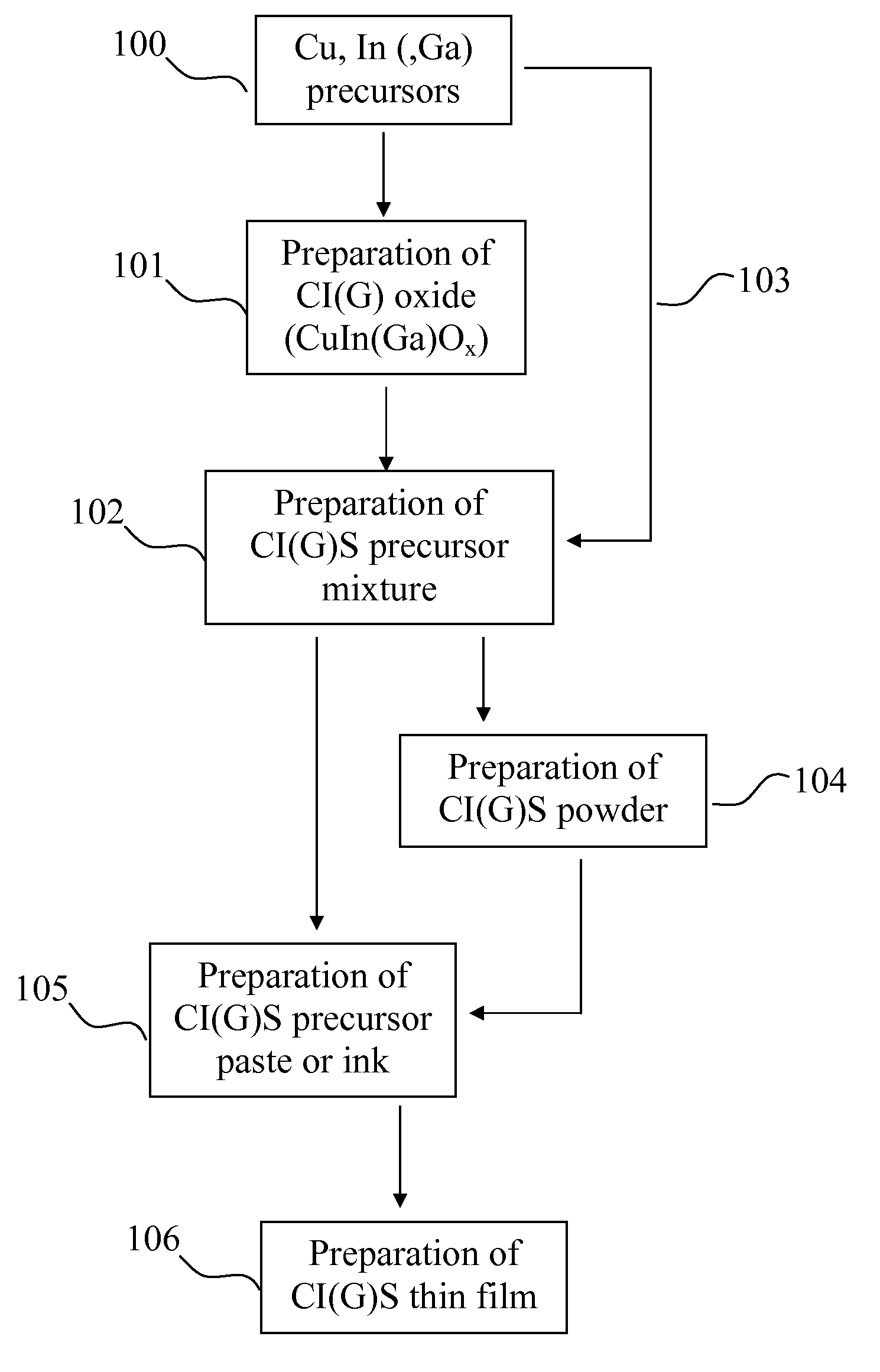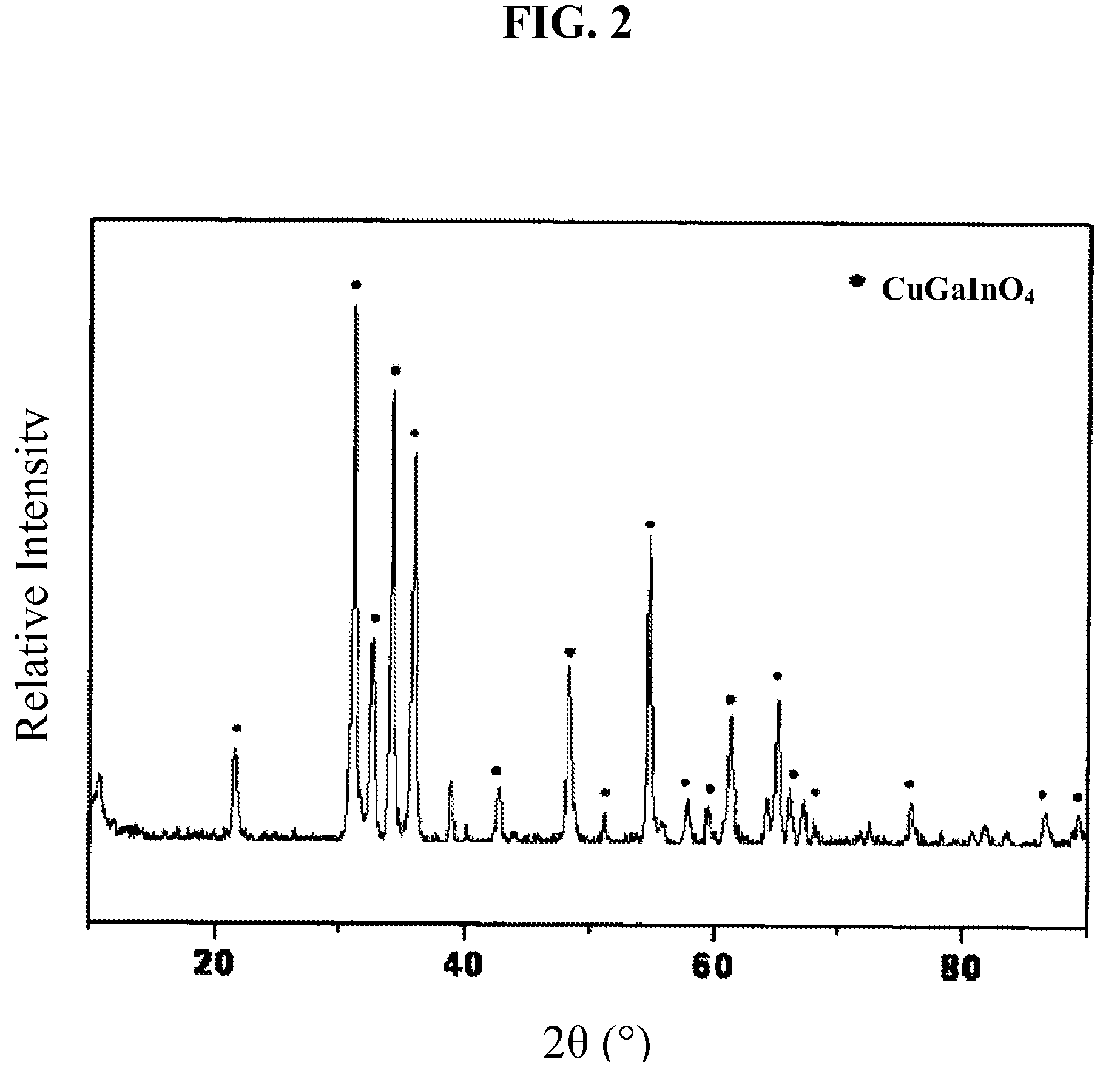Preparation of thin film for solar cell using paste
- Summary
- Abstract
- Description
- Claims
- Application Information
AI Technical Summary
Benefits of technology
Problems solved by technology
Method used
Image
Examples
example 1
Preparation of a CIGS Thin Film Using a CIG Oxide
[0042]7.77 g (0.032 mol) of Cu(NO3)2.3H2O, 10.23 g (0.034 mol) of In(NO3)2.3H2O and 8.70 g (0.034 mol) of Ga(NO3)2.3H2O were dissolved in 30 mL of water, the pH was adjusted for 7 using NaOH (1M), and stirred for a day. The precipitates were isolated by filtering, dried at 110° C. for a day, and then heated at 800° C. for 5 hours to obtain a CIG oxide (CuInGaO4).
[0043]0.83 g (0.0027 mol) of the resulting CIG oxide and 1.17 g (0.0053 mol) of SeCl4 were added to 50 mL of ethanol, and then stirred thoroughly to obtain a CIGS precursor mixture. 10 g of α-terpienol (a dispersing agent) and 0.75 g of ethyl cellulose (a binder) were dissolved in 20 mL of ethanol, mixed with the CIGS precursor mixture, and the resulting mixture was stirred, followed by evaporating the solvent at 40° C. to obtain a CIGS paste.
[0044]The CIGS paste was coated on a glass plate using a doctor blade method, and the resulting coat was heated at 400° C. for 40 minute...
example 2
Preparation of a CIGS Thin Film Using a Precursor Mixture
[0045]0.5 g (0.002 mol) of Cu(NO3)23H2O, 0.43 g (0.0014 mol) of In(NO3)2.3H2O and 0.16 g (0.0006 mol) of Ga(NO3)23H2O were mixed in 60 mL of ethanol, 1.17 g (0.0053 mol) of SeCl4 was added to the resulting mixture, and the whole mixture was stirred thoroughly to obtain a CIGS precursor mixture. 10 g of α-terpienol (a dispersing agent) and 0.75 g of ethyl cellulose (a binder) were dissolved in 20 mL of ethanol, mixed with the CIGS precursor mixture, and the resulting mixture was stirred, followed by evaporating the solvent at 40° C. to obtain a CIGS paste. The CIGS paste was coated on a glass plate using a doctor blade method, the coat was heated at 400° C. for 40 minutes under a H2 / Ar (5:95) atmosphere to obtain a CIGS thin film.
example 3
Preparation of a CIGS Thin Film Including Heat Treatment Under Ambient Atmosphere
[0046]The CIGS paste prepared by the procedure of Example 1 was coated on a glass plate using a doctor blade method, and the resulting coat was heated at 250° C. for 60 minutes under ambient atmosphere followed by heat treatment at 400° C. for 40 minutes under a H2 / Ar (5:95) atmosphere, to obtain a CIGS thin film.
PUM
| Property | Measurement | Unit |
|---|---|---|
| Temperature | aaaaa | aaaaa |
| Temperature | aaaaa | aaaaa |
| Temperature | aaaaa | aaaaa |
Abstract
Description
Claims
Application Information
 Login to View More
Login to View More - R&D
- Intellectual Property
- Life Sciences
- Materials
- Tech Scout
- Unparalleled Data Quality
- Higher Quality Content
- 60% Fewer Hallucinations
Browse by: Latest US Patents, China's latest patents, Technical Efficacy Thesaurus, Application Domain, Technology Topic, Popular Technical Reports.
© 2025 PatSnap. All rights reserved.Legal|Privacy policy|Modern Slavery Act Transparency Statement|Sitemap|About US| Contact US: help@patsnap.com



